Fly Fishing Chile – On My Own
 To a fly fisherman Chile is the Shangri-La of the trout fishing world. It is one of those places that most of us have on our life list of place to go before we have that last great long distance release of our lives. I’m no different than any other red blooded fly fisher. I wanted to have Chile on my list of places I had fly fished. And, hell I’m not getting any younger. I needed to do it while I still could.
To a fly fisherman Chile is the Shangri-La of the trout fishing world. It is one of those places that most of us have on our life list of place to go before we have that last great long distance release of our lives. I’m no different than any other red blooded fly fisher. I wanted to have Chile on my list of places I had fly fished. And, hell I’m not getting any younger. I needed to do it while I still could.
Chile, stretching over 2,700 miles from North to South and never over 110 mile wide from East to West, has a little of everything. But for fly fishing the only choices are the Lake Region near Puerto Montt or further down into Patagonia. Being a confirmed small to mid-sized stream fisherman the place for me was central Patagonia.
An internet search suggested that I could expect a cost in the neighborhood of $600 or more a day at one of the Patagonian lodges. Since most are week long trips, the price would be over $4,000. Now my two sons say I’m cheap, I prefer to be known as frugal. I figured that on my own I could get by for $100 a day or less, that would be frugal.
Most of the lodges appear to be owned, not by locals, but by Americans from the West. And, most of the guides are 20 something Americans from Montana and Wyoming. As one with an adventuresome spirit it would have been next to impossible for me to learn anything about the soul of Chile while staying in an American owned lodge and fishing with American guides. Since all the other areas of the world I have fished have been on my own so why should Chile be any different?
While I like to say I did my fishing adventure on my own that is really not correct. I did my adventuring with the help of friends. Some had done trips on their own, some had done tours and some knew someone who knew someone in Chile. As with anything, a network is a terrific thing to have!
When to Go
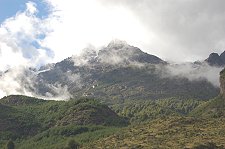 Being south of the equator, Patagonia’s seasons are the reverse of ours, our winter is their summer and that is the time to go. Chile’s open season is from the 1st of November through the 30th of April. I fished between the 11th and 18th of January, the only time my schedule allowed me to be there. Based on my experience, I was there a few weeks to early. It was still cool and the fishing seemed to be getting better as the week went on. Temperatures, both air and water, were slowly rising, I started seeing some grasshoppers and fish seemed to be more active. If I could choose the time to be there it would be the in early to mid February, the time my friend Ray from Pennsylvania goes there!
Being south of the equator, Patagonia’s seasons are the reverse of ours, our winter is their summer and that is the time to go. Chile’s open season is from the 1st of November through the 30th of April. I fished between the 11th and 18th of January, the only time my schedule allowed me to be there. Based on my experience, I was there a few weeks to early. It was still cool and the fishing seemed to be getting better as the week went on. Temperatures, both air and water, were slowly rising, I started seeing some grasshoppers and fish seemed to be more active. If I could choose the time to be there it would be the in early to mid February, the time my friend Ray from Pennsylvania goes there!
Getting There
Several airlines fly non-stop from the US to Santiago. Once in Santiago the next decision is where in Patagonia to go - Coyhaique is fast becoming the epicenter of Patagonian fly fishing. This area, located south of the Chilean Lake District has the greatest diversity of fly fishing opportunities. The Andes provide the snow melt to fuel large rivers while the pampas offers spring creeks and smaller rivers and streams. Coyhaique is the regional center with a population of about 35,000. It has everything a traveling trout fisherman could want - Coyhaique became my base of operation.
The fastest way to get to Coyhaique is to fly from Santiago via Puerto Montt, a flight of just over 2 hour; the round trip fare is just over $600. I opted for a one-way ticket, I’d figure out how to get back later. Since Coyhaique is surrounded by mountains and not conducive to landing 737’s, the flight actually lands in Balmaceda, a small pampas village about 30 miles to the southeast of Coyhaique. If you have ever flown into Aspen, Colorado or Jackson Hole, Wyoming you appreciate the airport being up on the pampas! There are some alternatives to flying all the way. You can take a bus from Santiago to Orsono – about 9 hours – and transfer there to another bus to Coyhaique via Argentina. You have to go through Argentina because the Carreterere Austral, the only north-south highway hasn’t been completed between Puerto Montt and Chiatan. The Argentinean connection is almost 24 more hours. A third option would be to take a bus from Santiago to Puerto Montt, from Puerto Montt you can take a ferry to Chiatan, in Chiatan you could either rent a vehicle or take a bus to Coyhaique. Being frugal, on my way back to Santiago I flew from Balmaceda to Puerto Montt ($190) and took an overnight bus to Santiago. I chose the “Salon” class which provides deeply recline seats, a light dinner meal and a light breakfast at a cost of about $50.
Getting Around
Doing it on your own means you have to rent a car. Two major rental agencies, Budget (who I used) and Hertz have counters at the Balmaceda airport both rent compact cars, SUV’s and 4X4 pick-up trucks. There are also numerous car rental locations in Coyhaique, all of which are local and not affiliated with any large operation. In the event of a problem I’m not sure what the level of support might be. Additionally, if you rent in Coyhaique you would have to take a shuttle from the airport into Coyhaique at a roundtrip cost of about $30. Car rental is expensive. Without someone to split the cost, I opted for a compact car and was given a Toyota Yaris. If I had been sharing the cost, the best option would be a 4 door, 4 wheel drive small pickup truck.
Almost all the roads, including most of the Carreterere Austral are gravel. The Yaris handled the roads I traveled without any problems, but a couple of times I would have gone a bit further if I had had more ground clearance.
Places To Stay
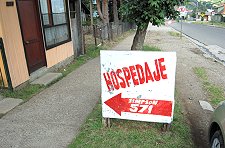 Coyhaique has a wide range of lodging options from hotels to cabins to B and B’s to private rooms. As you can guess the prices cover an entire range as well. By far the most economical option is one of the many “hospedaje’s”. These are basically rooming houses or as I say a B with any B in the morning. These cost between $11 and $15 per night with a shared bath. Hotels are between $50 and $70 per night (single). For a group of 3 or 4 cabañas are reasonable at $100 to $150 a night.
Coyhaique has a wide range of lodging options from hotels to cabins to B and B’s to private rooms. As you can guess the prices cover an entire range as well. By far the most economical option is one of the many “hospedaje’s”. These are basically rooming houses or as I say a B with any B in the morning. These cost between $11 and $15 per night with a shared bath. Hotels are between $50 and $70 per night (single). For a group of 3 or 4 cabañas are reasonable at $100 to $150 a night.
Outside of Coyhaique there are few places to stay. Manihuales, a small town about 40 miles north of Coyhaique has one hospedaje with 3 rooms but it was full each time I stopped. That leaves just two real options of lodging, you can return to Coyhaique each night or camp. Not having camping gear with me, I returned to Coyhaique every night. Since the roads were not the greatest, and depending on where I had fished that day, often twisting through the mountains I made sure I was back before dark. This severely limited the areas I could fish.
Places To Fish
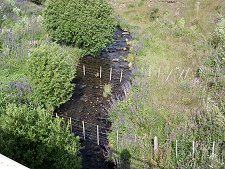 Fishing is either in the rivers and streams or in the lakes. The big lakes are known as lago’s while the smaller ones are laguna’s. If you are looking for BIG trout these are the places to fish. Other than a few areas of the shore line and possibly the inlets or outlets they are virtually unfishable without a boat.
Fishing is either in the rivers and streams or in the lakes. The big lakes are known as lago’s while the smaller ones are laguna’s. If you are looking for BIG trout these are the places to fish. Other than a few areas of the shore line and possibly the inlets or outlets they are virtually unfishable without a boat.
For rivers and streams the answer of where to fish in Patagonia is “anyplace there is a stream!” I caught trout in every stream I fished. Come to a bridge, find a place to pull off the road and go down to the river. The hard part was getting to the water. The Chileans love their fences! A typical fence was 6 or 7 strands with a strand barbed wire near the top and another one near the bottom. Posts were set ever 12 to 15 feet apart with the wire attached to slates between the posts. Your hope was that you could crawl under the fence or find a hole in the fence.
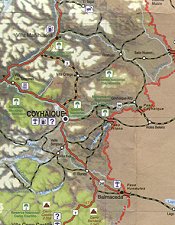 On your own, you are primarily limited to the smaller wadeable streams and rivers. Like the lakes and lagoons it is hardly worth your time trying to fish the big rivers like the lower Simpson or the Manihuales without a boat. There is more than enough smaller water to keep you occupied. In seven days, I fished 14 different locations including some of them more than once. I also passed up several others because of time constraints.
On your own, you are primarily limited to the smaller wadeable streams and rivers. Like the lakes and lagoons it is hardly worth your time trying to fish the big rivers like the lower Simpson or the Manihuales without a boat. There is more than enough smaller water to keep you occupied. In seven days, I fished 14 different locations including some of them more than once. I also passed up several others because of time constraints.
The character of the rivers is determined in large part by where it is located, in the mountains or up on the pampas.
Mountain rivers tended to have better habitat than the pampas rivers but were often limited in their accessibility. 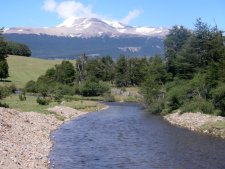 They were either located in steep narrow valleys or had carved an impassable gorge through the rock. Often the gorge was only 50 to 100 yards long before the river open back into a valley. In most of valleys there was a small ranch reachable by a long twisting track. Not speaking any Spanish I was reluctant to drive up to the gate and start fishing. I think if you were able to ask permission, you would likely be given access to a lot of water.
They were either located in steep narrow valleys or had carved an impassable gorge through the rock. Often the gorge was only 50 to 100 yards long before the river open back into a valley. In most of valleys there was a small ranch reachable by a long twisting track. Not speaking any Spanish I was reluctant to drive up to the gate and start fishing. I think if you were able to ask permission, you would likely be given access to a lot of water.
Pampas rivers were wide open and didn’t have the limitations of how far you could fish without running into a gorge or other restriction. 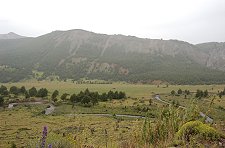 Their problem was the WIND and limited amounts quality habitat. The substrate, baseball to softball sized rock, doesn’t provide much holding water. Even at bends, undercut banks rarely developed. But anyplace that there was any habitat there were fish and lots of them. When the habitat was good there were good fish.
Their problem was the WIND and limited amounts quality habitat. The substrate, baseball to softball sized rock, doesn’t provide much holding water. Even at bends, undercut banks rarely developed. But anyplace that there was any habitat there were fish and lots of them. When the habitat was good there were good fish.
And then there were those rivers in the transition between the mountains and the pampas that had the best of both worlds – long easily accessible reaches with good habitat. These locations produced a lot of fish and some very good sized fish.
The Quality of the Fishing
I was lead on by the hype from the magazine stories and the lodge ads, so I was a bit disappointed in the
fishing. I thought I would catch a lot of big fish. I did catch a lot of fish and a few nice fish, but on a rating scale I would put it somewhat below Wyoming’s Upper North Platte River Valley. The number of fish I caught each day was amazing. Although most days I rarely fished for more than 4 hours, I have no doubt that I generally caught 50 plus fish a days. In one pool, for one of these streams that had the best of both the mountain and pampas conditions, I took 17 browns before I quit and moved on to another location.
Most of the fish I caught were in the 10 to 12 inch range with maybe one in ten being about 14 inches and one in 20 in the 16 to 18 inches range. All the fish were extremely health and were very acrobatic. On more than one occasion I was sure I had the “Oh Sh*t” fish only to have it be 14 inches. My biggest fish of the trip was a rainbow approaching 24 inches, that fish came from an unnamed tributary of Lago Elizalde.
All my fish were caught on dry flies and all but two were caught on a caddis pattern of one type or another. Of the other two not caught on a caddis, one was caught on a foam ant given to me by my STREAM SIDE ADVENTURES associate Preston Larimer and the other was on a hopper pattern given to me by president of Heart Of America
Fly Fishers, Mark Borserine.
Next Time
I definitely would make the trip again. It is kind of a no brainer. Winter in the mid-west or summer in Patagonia. But next time I’ll do things differently. Here is what I’ll do:
Find some one to make the trip with me. With someone to split up checking camping gear on the flight down, you would have a lot more flexibility in where you fished. By not having to come back to Coyhaique every night you could fish some new water. Vehicle rental is expensive, so splitting the cost of a 4X4 pick up would be nice.
Don’t fly internally. Take the night bus between Santiago and Puerto Montt rather than fly. Internal airfares are high! The bus is only about a quarter of the cost. The Salon class is comfortable and you can sleep just fine. From Puerto Montt you can take a ferry Chiatan. In Chiatan you could find a rental vehicle or continue on to Coyhaique by bus. Since I already know the area around Coyhaique I think I’d opt getting a vehicle in Chiatan.
Go a few weeks later. It was still relatively cool when I first arrived in Coyhaique on January 11th. On the morning of January 13th there was a light dusting of snow on the tops of some of the mountains. For the first few days I generally kept my fleece on until well after noon. On the last few days it was much warmer and the fishing started to get better.
Learn some Spanish. Although I was able to get by just fine without speaking any Spanish it would be much easier with even a rudimentary knowledge. Being able to ask for permission to fish at the small ranches would likely open up a lot more water to you.
Stay longer. Doesn’t need any explanation!